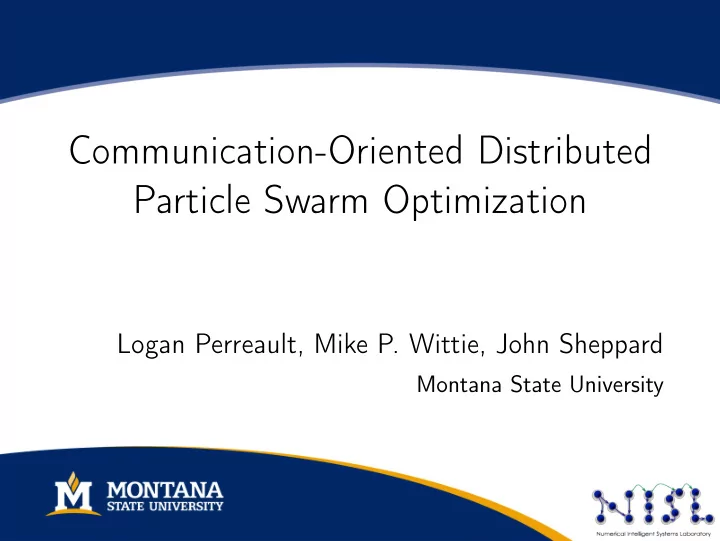

Communication-Oriented Distributed Particle Swarm Optimization Logan Perreault, Mike P. Wittie, John Sheppard Montana State University
Particle Swarm Optimization State Update: ◮ A particle’s state represents a potential solution. ◮ x i = v i + x i Velocity Update: v i = ω v i + U ( 0 , φ 1 ) ⊗ ( p i − x i ) + U ( 0 , φ 2 ) ⊗ ( p g − x i )
Particle Swarm Optimization State Update: ◮ A particle’s state represents a potential solution. ◮ x i = v i + x i Velocity Update: v i = ω v i + U ( 0 , φ 1 ) ⊗ ( p i − x i ) + U ( 0 , φ 2 ) ⊗ ( p g − x i ) v i = ω v i + Φ 1 Cognitive () + Φ 2 Social ()
Distributed PSO PSO for Robotic Swarms ( dPSO ) Instead of virtual particles, use physical robots. ◮ unreliable update ◮ propagation of global best Previous Work J. M. Hereford, 2006 J. Pugh and A. Martinoli, 2008
Motivation Previous Work Did Not Consider Mobile Targets Previous experiments only attempted to track static targets. ◮ How well can dPSO track a moving target? ◮ What adaptations need to be made to achieve this? Previous Work Ignores Server Communication Standard dPSO communicates global best to other particles. ◮ Only useful if you can retrieve the information ◮ Transmit solutions back to a server
Problem Example
Our Approach to Improving Server Communication Goal: Periodically relay the current best solution to a central server. Introduce a Communication Goal The approach we take is to integrate a communication goal into the fitness function. ◮ Cognitive and social terms draw particles toward solution ◮ Communication term draws particles toward server
Notation c Target number of timesteps before communication with the server is restored
Notation c Target number of timesteps before communication with the server is restored θ i Unique offset for each particle θ i = R id × c / N
Notation c Target number of timesteps before communication with the server is restored θ i Unique offset for each particle θ i = R id × c / N t c The last timestep where successful communication with the server was made
Communication-Oriented Velocity Update Rule � t − t c � � ��� v i = ω v i + 1 − min 1 , Φ 1 Cognitive () c + θ i � t − t c � � ��� + 1 − min 1 , Φ 2 Social () c + θ i � t − t c � �� + min 1 , Φ 3 Communication () c + θ i
Fitness Evaluation for the Communication Goal The new communication term requires a new fitness function. ◮ Defined by the number of hops H required to reach the server. ◮ Exponential decrease in fitness as hops increase. fitness c = 1 d H
Our Approach to Tracking Dynamic Targets Goal: Find and track targets that are in motion. Decay We decay the three fitness values for each particle as follows: f i ← β 1 f i f g ← β 2 f g f c ← β 3 f c
Experimental Design We implemented dPSO and C-dPSO in a simulated environment. ◮ communication range limited to 25% of search space ◮ notion of global best must be propagated We conducted 9 experiments to test our contributions. ◮ 8 particles, 1 server, 1 target ◮ 500 noisy points with fitness from 0% to 5% of target ◮ 1000 randomized iterations per experiment ◮ Parameters were tuned experimentally ( β k was insensitive) Measurements were taken in terms of server error.
Fitness Evaluation for the Communication Goal Summary of Experiments Experiment Target Dynamic 1 Mobile Dynamic 2 Decay Dynamic 3 Fast Decay Dynamic 4 Mobile Fast Decay Comm 0 Static Comm 1 Mobile Comm 2 Decay Comm 3 Fast Decay Comm 4 Mobile Fast Decay
Fitness Evaluation for the Communication Goal Dynamic Results in Euclidean Distance Experiment C-dPSO C-dPSO Decayed p-value Mobile 53.435 < 0.00001 1.263 Decay 8.823 6.879 0.09863 Fast Decay 12.071 0.04702 9.419 Mobile Fast Decay 53.586 27.936 < 0.00001
Fitness Evaluation for the Communication Goal Communication Results in Euclidean Distance Experiment dPSO C-dPSO p-value Static 8.308 4.338 0.00008 Mobile 5.351 < 0.00001 1.263 Decay 10.159 6.879 0.00499 Fast Decay 15.160 0.00005 9.419 Mobile Fast Decay 30.072 27.936 0.00309
C-dPSO Tracking a Mobile Target
Conclusion C-dPSO We proposed C-dPSO as an alternative to standard dPSO . ◮ Particles relay information to servers with more consistency. ◮ Fitness value decay helps to track mobile targets. Future Work ◮ Examine problems with mobile servers. ◮ Investigate effects of a server with larger communication range. ◮ Implementation on physical robots.
Thank You!
Recommend
More recommend